
Foreword →
From Transformation Debt to Digital Dividend
In our years of guiding organizations through complex technological shifts, we have observed a recurring paradox: the more an enterprise invests in digital transformation, the greater the risk of accumulating “transformation debt.” This is the growing chasm between the promise of innovation and the tangible value realized. It manifests as frustrated employees, fragmented processes, and a technology stack that, despite its sophistication, becomes a source of paralysis rather than progress.
Today, the advent of Generative AI represents the most significant technological accelerant of our time. It has the power to turn this transformation debt into an insurmountable liability for those who are unprepared, while offering an unprecedented “digital dividend” to those who master its integration.

This document is not another treatise on the importance of technology. It is a blueprint for a new methodology. It outlines our proprietary Operations Integration and Intelligence (OI) Approach—a holistic framework designed to close the gap between technology and the people who use it. We will demonstrate that the key to unlocking the true value of any platform, especially in the age of AI, lies not in the technology itself, but in a relentless focus on human adoption and continuous, data-driven improvement.
This is the Transformation Continuum. It is the pathway from paralysis to HyperProductivity, and we are proud to be your guide on this essential journey.
Executive Summary →
The Tipping Point of Digital Transformation
The modern enterprise is at a critical inflection point. A projected $5.61 trillion will be invested in IT globally in 2025, yet the returns are diminishing at an alarming rate. The average large enterprise now loses $104 million annually to digital inefficiencies, a direct consequence of “Software Paralysis”—a state where a sprawling, underutilized technology stack actively hinders productivity and stifles innovation. Traditional System Integrators (SIs), with their myopic focus on technical “go-live” over human adoption, have proven incapable of solving this crisis.
The dawn of Generative AI has only raised the stakes. It promises to amplify the success of innovators while accelerating the decline of laggards. The difference between these two outcomes will be defined by one thing: the maturity of their digital adoption strategy.
A new paradigm is essential—one that treats transformation not as a finite project, but as a continuous journey. This is the Transformation Continuum, a model pioneered by erpOI. Our proprietary Operations Integration and Intelligence (OI) Approach is the engine that drives this continuum. It is a holistic methodology that fundamentally realigns the fractured relationship between People, Processes, and Technology. It is the blueprint for creating “Elite Digital Adopters”—the top 7% of organizations that achieve a remarkable 85% ROI on their transformation projects, compared to a mere 22% for those who follow outdated methods.
creates a cohesive, high-performance unit where technology serves the user and processes are intuitive.
leverages a data-first strategy to provide clarity, identify friction, and guide continuous improvement.
This whitepaper details the erpOI OI Approach and demonstrates how, when activated by the market-leading Digital Adoption Platform (DAP), WalkMe, it delivers transformative results. Through in-depth use cases, we will prove how erpOI moves beyond simple implementation to unlock the true, sustained value of your technology investments and sets your organization on the path to HyperProductivity.
Chapter 1: The Digital Paradox - A Crisis of Diminishing Returns
1.1 The $5.61 Trillion Question: Why Record IT Spend Yields Stagnant Productivity
Despite a global economic climate marked by uncertainty, enterprise investment in technology has never been higher. According to Gartner, global IT spending is projected to climb from $5.1 trillion in 2024 to $5.61 trillion in 2025. Enterprises are aggressively increasing their digital transformation budgets by an average of 45% year-over-year.
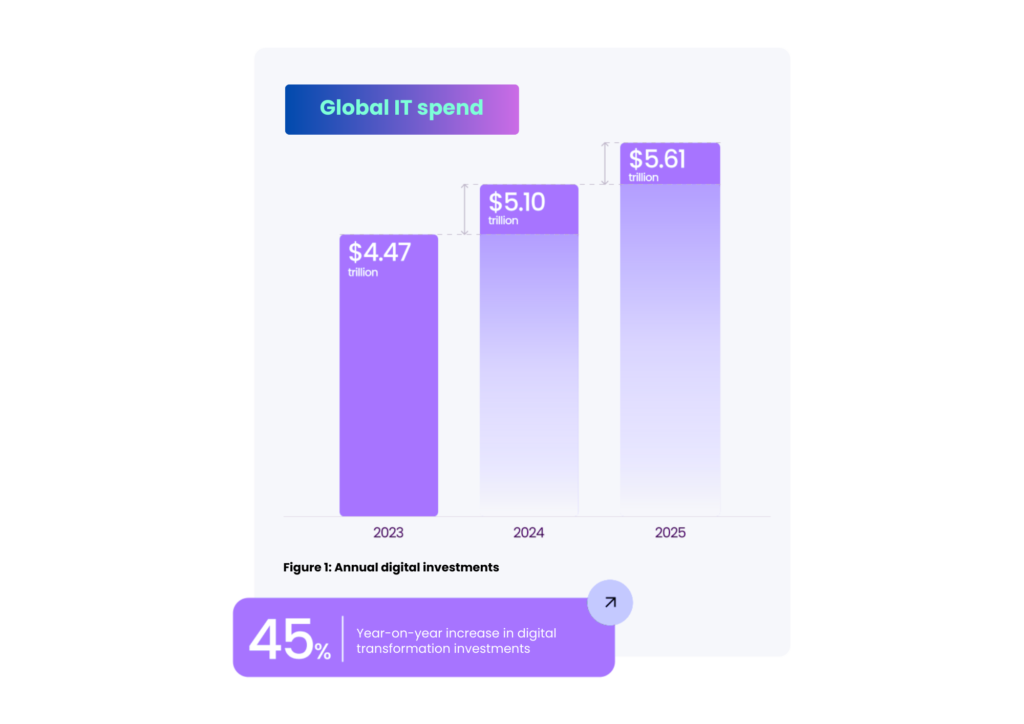
Yet, this record spending is not translating into proportional gains in productivity or value. In 2024, the average large enterprise lost $104 million from digital inefficiencies. This staggering figure can be broken down into three core areas of failure:
Direct costs from employee time spent grappling with technology frustrations and inefficient workflows.
Strategic costs incurred from poor visibility and the underutilization of enterprise applications.
Investment losses from technology initiatives that fail to deliver ROI due to low user adoption.
This is the digital paradox: as investment in technology accelerates, the value realized stagnates, creating a widening gap between expenditure and outcome.
1.2 Deep Dive: The 1,600% Visibility Gap
The root of this paradox lies in a profound lack of awareness. As revealed in the 2025 State of Digital Adoption Report, enterprises dramatically underestimate the complexity of their own tech stacks by an astonishing 1,600%.
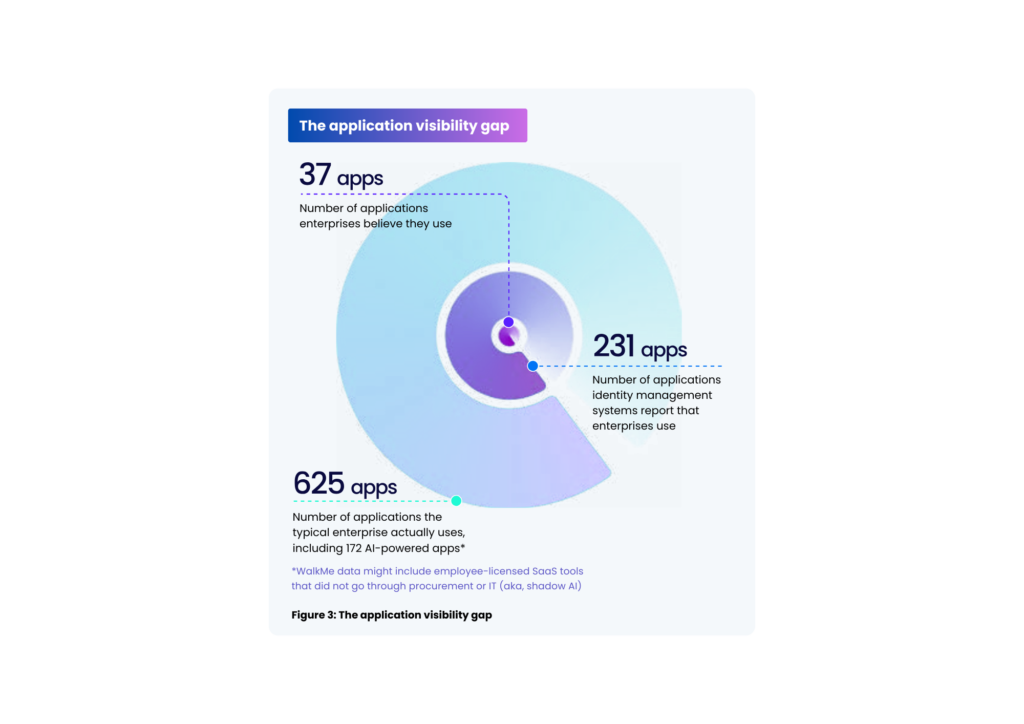
This massive visibility gap makes effective governance impossible. It leads directly to “Software Residue”—a term for redundant and overlapping applications. Our research shows that 20% of enterprise applications duplicate the features of other tools in the tech stack, representing millions in wasted licensing fees and contributing to a state of pervasive Software Paralysis. Without a clear understanding of what tools are in use, organizations cannot begin to optimize their processes or their investments.
1.3 The Human Cost: 36 Wasted Workdays and the "Toggle Tax"
The financial cost of this inefficiency is immense, but the human cost is equally devastating. The modern employee’s workflow is fragmented across an average of 10+ applications to complete a single task. This constant context-switching imposes a heavy “Toggle Tax” on productivity and morale.
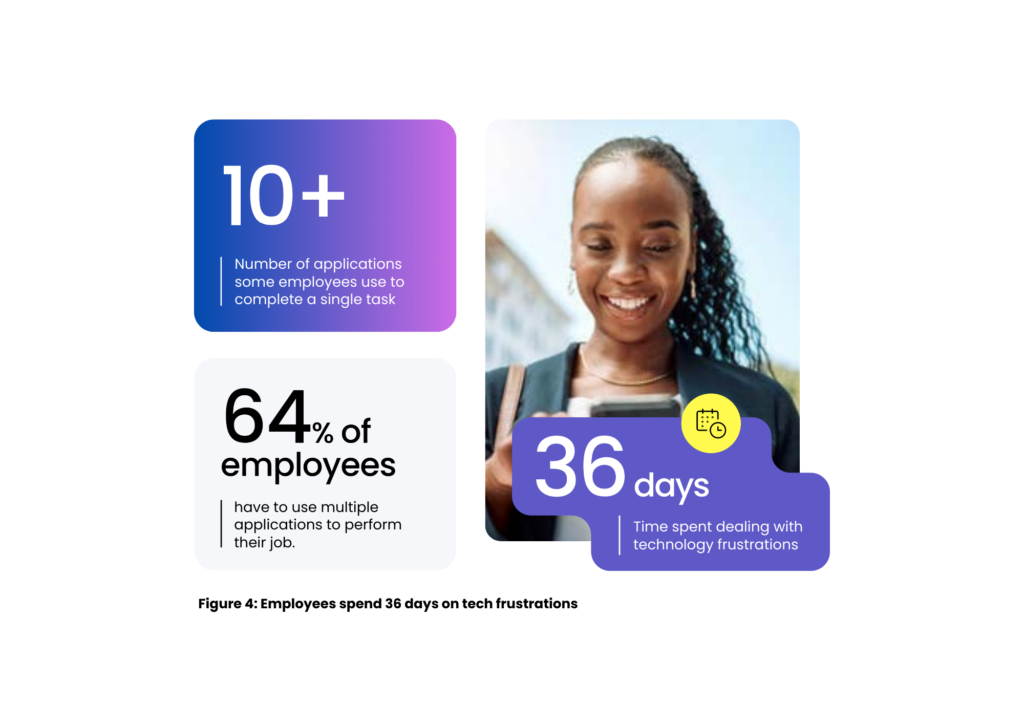
Our analysis, supported by the 2024 State of Digital Adoption Report, reveals the stark reality of the employee experience:
- The average employee loses the equivalent of 36 full working days per year dealing with technology frustrations and compensating for a lack of application proficiency.
32% of employees regularly have to work late because of hard-to-use technology. This frustration is a direct path to burnout and turnover, with over 65% of new employees losing patience with their enterprise software in just 132 days.
The friction is not trivial. 31% of employees have missed or made mistakes with holiday or sick leave requests in the past year due to poorly designed HR systems.
This is not a sustainable model. When the tools designed to empower employees become their biggest source of frustration, the entire foundation of digital transformation crumbles.
Chapter 2: The AI Accelerant - Navigating the Next Industrial Revolution
2.1 The Inevitable Integration: AI as 28% of the Enterprise Tech Stack
The digital paradox described in Chapter 1 is about to be supercharged. Generative AI is no longer an emerging technology; it is an integrated and rapidly expanding part of the enterprise ecosystem. Our analysis of over 2,400 enterprise applications reveals that AI-powered tools now account for 28% of the typical enterprise tech stack. This integration is happening at a pace that far outstrips previous technological shifts, forcing organizations to react.
However, the dominant reaction is one of dissonance. Leaders see the potential, but the workforce experiences the friction. This creates a dangerous gap between strategy and execution.
2.2 Deep Dive: The Great Disconnect
While executive suites are bullish on AI, a profound chasm exists between their strategic ambitions and the reality of employee readiness. This “Great Disconnect” is the single biggest threat to successful AI adoption and is clearly illustrated by the data:
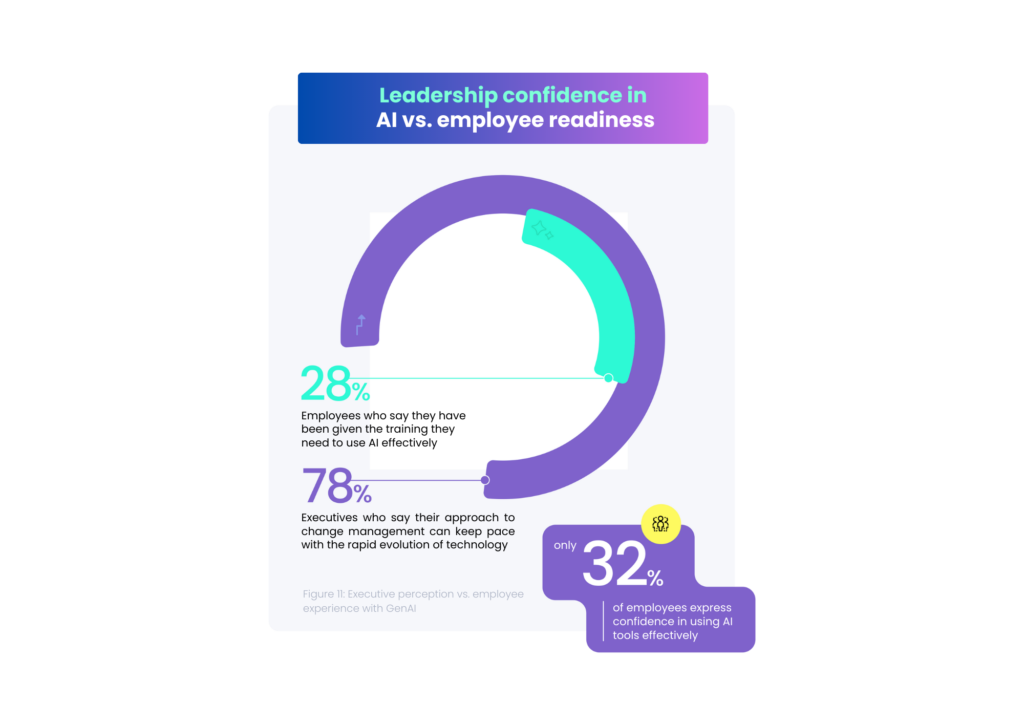
This disconnect is further illuminated by the divergent priorities of each group:
Leaders are focused on high-level outcomes. Their top priorities for GenAI are Performance Analytics (49%), Task Automation (40%), and Contextual Software Assistance (38%). They see AI as a tool for strategic gains.
Employees are focused on immediate, practical needs. Their top priorities are Application Guidance (52%), Risk Detection (47%), and Integration Between Existing Tools (44%). They see AI as another complex system they must learn to navigate safely and effectively.
Without a methodology to bridge this gap, organizations are simply investing in sophisticated technology that their workforce is unprepared and unequipped to use, ensuring a poor return on their substantial AI investments.
2.3 The Rise of Shadow AI and the Governance Imperative
The visibility gap is not limited to sanctioned software. The ease of access to consumer-grade AI tools has led to a surge in “Shadow AI”—the unsanctioned use of AI applications by employees to perform work tasks. While often born of a desire to be more productive, Shadow AI introduces significant risks, including data leakage, compliance violations, and the creation of insecure, unsupported workflows. The 172 AI-powered apps found in the average enterprise tech stack include many such unsanctioned tools, making a comprehensive governance strategy more critical than ever.
2.4 AI: A Multiplier for Transformation Debt or a Catalyst for HyperProductivity?
The evidence is clear: Generative AI is an accelerant. For organizations mired in transformation debt—with fragmented processes, poor visibility, and a disconnected workforce—AI will only compound the chaos. It will widen the productivity gap, increase security risks, and accelerate financial losses.
However, for organizations that approach its integration with a mature, human-centric methodology, AI can be a powerful catalyst, unlocking unprecedented levels of efficiency and innovation. This state of elevated performance is what we at erpOI call HyperProductivity. The deciding factor is not the technology itself, but the strategic approach to its adoption.
Chapter 3:The Methodological Divide -Why Traditional Implementations Fail
3.1 The "Go-Live" Fallacy: How the SI Model Engineers a 22% ROI
For decades, the standard for technology deployment has been the traditional System Integrator (SI) model. This model is fundamentally project-based, with the technical “go-live” as its primary—and often, final—metric of success. This approach is the architect of the digital paradox. By prioritizing the technology over the user, the SI model structurally ignores the human factors that are essential for value creation.
The result is a dismal 22% ROI on digital transformation projects for organizations that fail to implement a structured digital adoption strategy. The system is live, the SI’s project is “complete,” but the value has been left on the table.
3.2 Deep Dive: Defining the "Elite Digital Adopter"
In stark contrast to the laggards are the “Elite Digital Adopters.” This top 7% of enterprises have moved beyond the “go-live” fallacy and embraced a comprehensive, human-centric approach to technology integration. The results are transformative: they achieve a remarkable 85% ROI on their digital transformation projects.
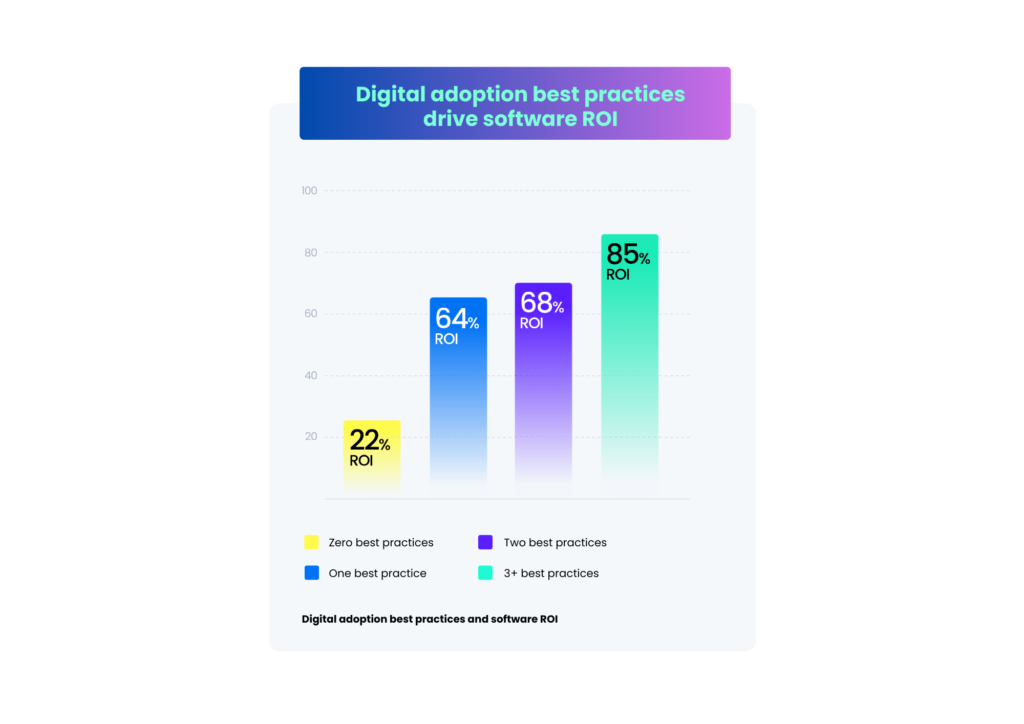
This ~4x difference in ROI proves that the methodology an organization uses to deploy technology is far more important than the technology itself. Elite Digital Adopters understand that adoption is not an event, but a continuous process driven by a set of core principles.
3.3 The 7 Digital Adoption Best Practices of Elite Organizations
Our analysis of the most successful organizations reveals a consistent pattern of behavior. Elite Digital Adopters build their strategy around seven core best practices:
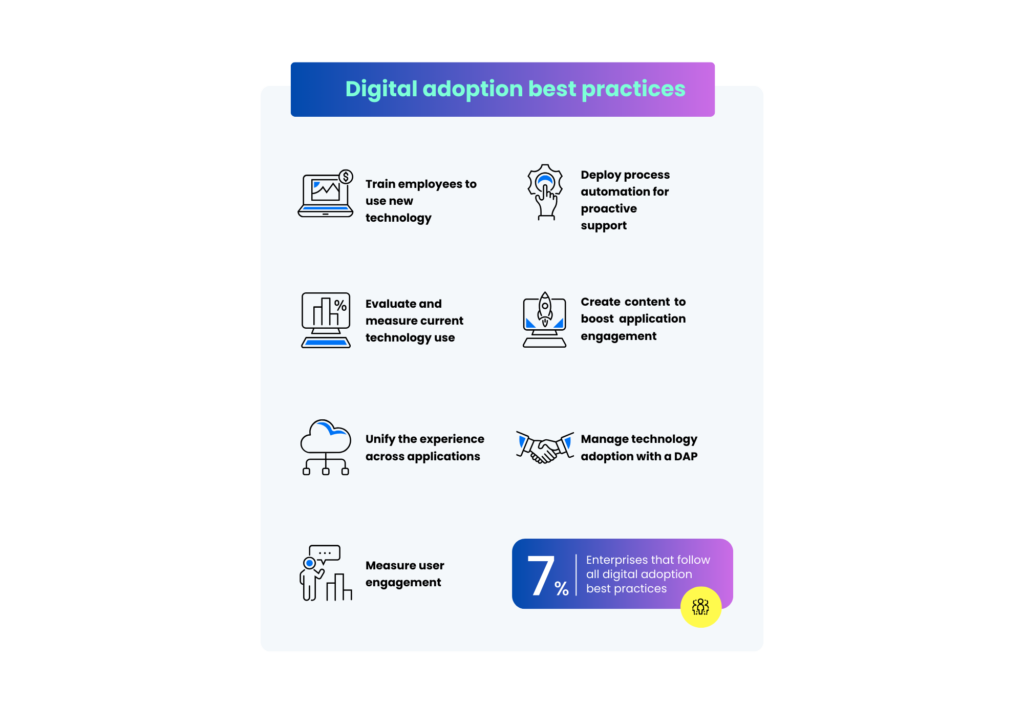
The 7 Best Practices Checklist
Moving beyond one-off sessions to continuous, in-flow enablement.
Gaining full visibility to make data-driven decisions.
Eliminating the “Toggle Tax” and creating seamless workflows.
Continuously monitoring for friction points and optimization opportunities.
Automating mundane tasks to free up human potential.
Providing the contextual help and resources users need, when they need it.
Utilizing a dedicated platform to orchestrate and scale the entire strategy.
3.4 The Role of the Center of Excellence (CoE) in Sustaining Elite Performance
Elite status is not achieved by accident, nor is it sustained without a dedicated focus. 73% of enterprises now have a Digital Adoption Center of Excellence (CoE) with six or more employees. This dedicated team is responsible for governing the digital adoption strategy, managing the DAP, and ensuring that best practices are consistently applied across the organization. The CoE is the organizational structure that operationalizes the principles of an Elite Digital Adopter.
The conclusion is inescapable: success in the modern digital landscape requires a fundamental shift away from the outdated SI model. It requires a new blueprint—one designed to create Elite Digital Adopters by systematically implementing a holistic, intelligent, and continuous approach to transformation.
Chapter 4: The erpOI Paradigm - A New Model for Continuous Evolution
The failures of the traditional, project-based model reveal the need for a new paradigm. At erpOI, we have developed a proprietary framework built for the realities of the modern digital enterprise. Our approach is not about managing a single project to completion; it is about embedding a capability for continuous evolution into the very fabric of an organization.
4.1 Visualizing the Journey: The Transformation Continuum
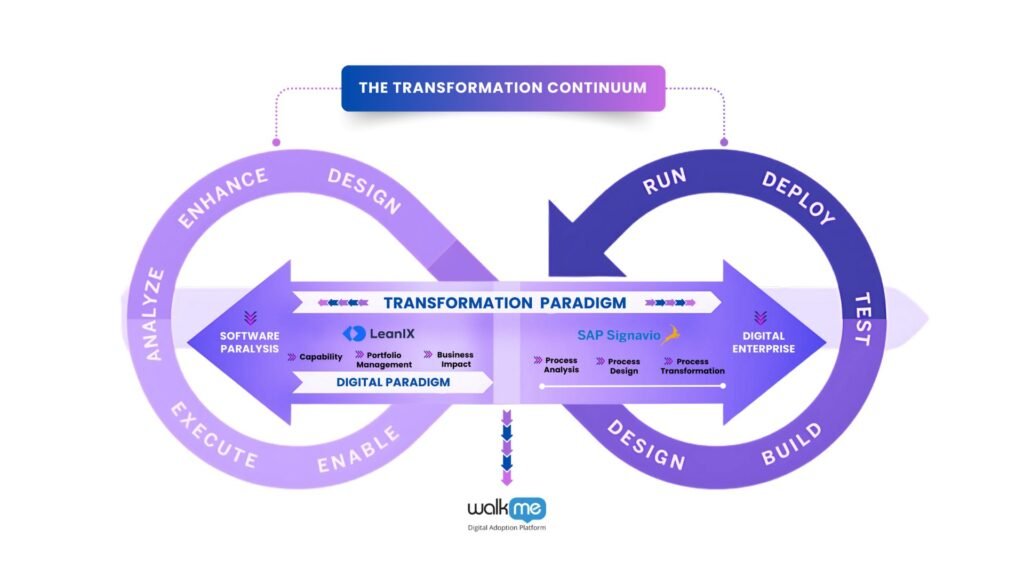
We reject the notion that transformation is a finite event with a beginning and an end. Instead, we see it as a perpetual journey: the Transformation Continuum. This model illustrates the spectrum of an organization’s digital maturity, from a state of “Software Paralysis”—where outdated systems and processes obstruct progress—to a dynamic state as a “Digital Enterprise,” characterized by agility and continuous innovation.
The goal is to move organizations permanently out of the gravitational pull of paralysis and into a sustainable orbit of continuous improvement. This requires a new operational engine.
4.2 Deep Dive: The Operations Integration & Intelligence (OI) Approach
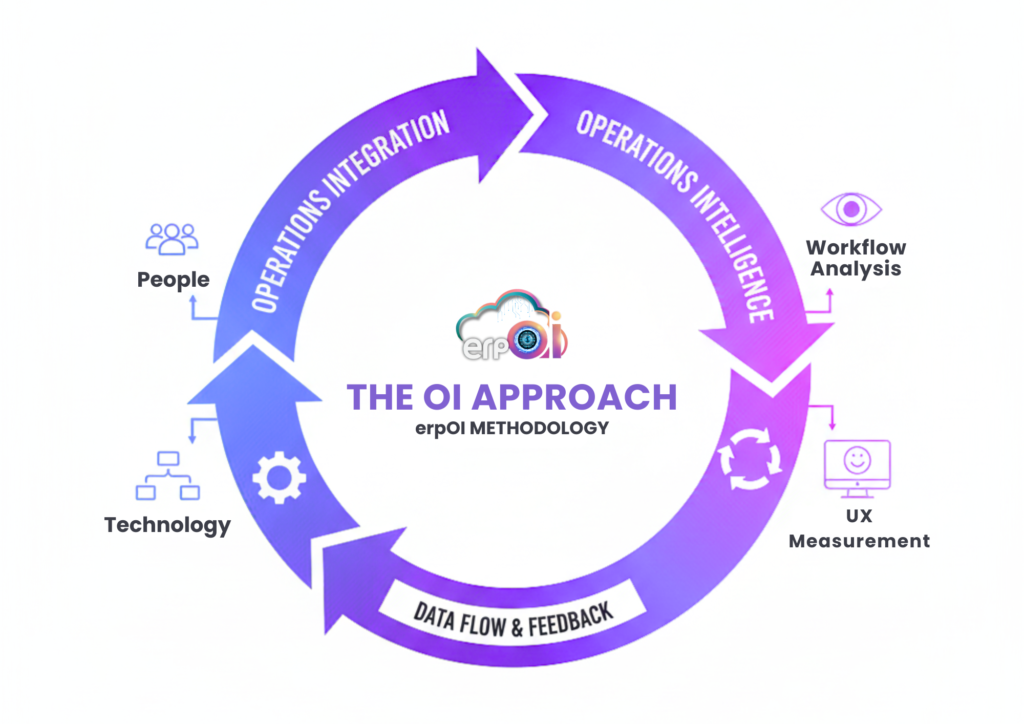
The engine driving the Transformation Continuum is our proprietary Operations Integration and Intelligence (OI) Approach. This is the core erpOI methodology for turning any organization into an Elite Digital Adopter. It is built on two synergistic pillars that form a continuous, self-improving loop.
Pillar 1: Operations Integration (The “How”) This pillar addresses the fundamental failure of traditional models by creating a single, cohesive, high-performance unit from the core elements of the business.
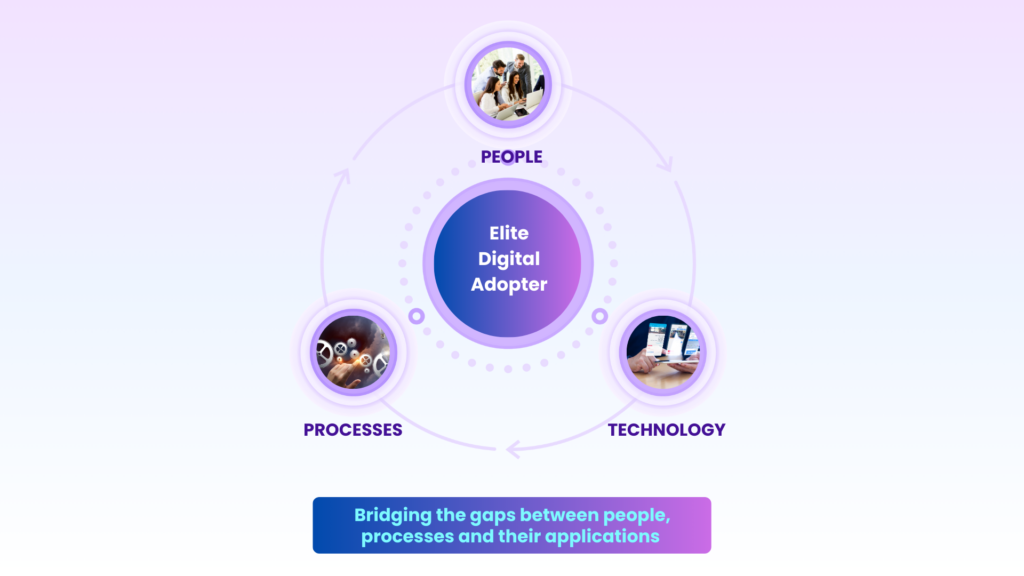
We shift the focus from episodic training events to continuous enablement. Our methodology ensures users are engaged, supported, and guided directly within their live workflows, fostering proficiency and confidence from day one. This directly addresses the “Great Disconnect” by building competence where it matters most.
We re-engineer processes with a human-centric focus. Instead of forcing users to adapt to rigid technology, we adapt the technological experience to the intuitive needs of the user. We use automation to eliminate friction, eradicate mundane tasks, and free employees for high-value strategic work.
We unify the tech stack not just at the data level, but at the user experience level. Our approach creates a seamless cross-application experience, treating the entire technology ecosystem as a single, coherent platform for getting work done.
Pillar 2: Operations Intelligence (The “Why”) This pillar replaces assumptions and guesswork with a data-first strategy, providing the clarity that 70% of enterprises currently lack.
Before we act, we assess. Leveraging Enterprise Architecture tools like SAP LeanIX, we map the entire IT landscape to expose redundancies, identify dependencies, and create a rational, data-driven foundation for the transformation roadmap.
We use advanced Business Process Mining tools like SAP Signavio to analyze end-to-end business processes as they truly exist. This allows us to move beyond theoretical process maps to identify the real-world bottlenecks, deviations, and inefficiencies that cripple productivity.
Finally, we deploy Digital Adoption Platforms to capture real-time, granular data on user interactions. We measure every click, hesitation, and error to identify the precise moments of friction that derail adoption and frustrate users.
The OI Approach creates a powerful feedback loop: Operations Intelligence provides the data-driven “why,” which informs the strategic actions taken within Operations Integration, leading to a continuously improving user experience and ever-increasing operational efficiency.
4.3 A Synergistic Tech Stack: How erpOI Leverages LeanIX and Signavio
Our OI approach is technology-agnostic in principle but strategically selects best-of-breed tools to deliver superior results. While WalkMe serves as our primary engine for user experience and adoption, our intelligence-gathering phase is significantly enhanced by our expertise in the broader SAP Business Transformation Suite.

SAP LeanIX for Strategic Alignment
LeanIX provides the “blueprint” of the enterprise. By visualizing the entire IT landscape, we can see how applications support business capabilities, identify aging technology that poses a risk (like an out-of-support SAP ECC system), and plan complex migrations like a move to S/4HANA with a clear understanding of all dependencies. This is the macro-level intelligence that ensures our adoption strategy aligns with the highest-level business objectives.

SAP Signavio for Process Excellence
While LeanIX provides the “what,” Signavio reveals the “how.” By mining and modeling existing workflows, we identify opportunities to standardize and optimize processes before embedding them in a DAP. This ensures we are not simply paving over broken paths, but are guiding users through a truly superior process, maximizing the ROI of the transformation.
This combination of strategic architecture management, deep process analysis, and real-time user adoption creates a multi-layered intelligence framework that is unique to erpOI, allowing us to design and implement solutions with unparalleled precision and impact.
Chapter 5: The erpOI Implementation Blueprint -From Strategy to Execution
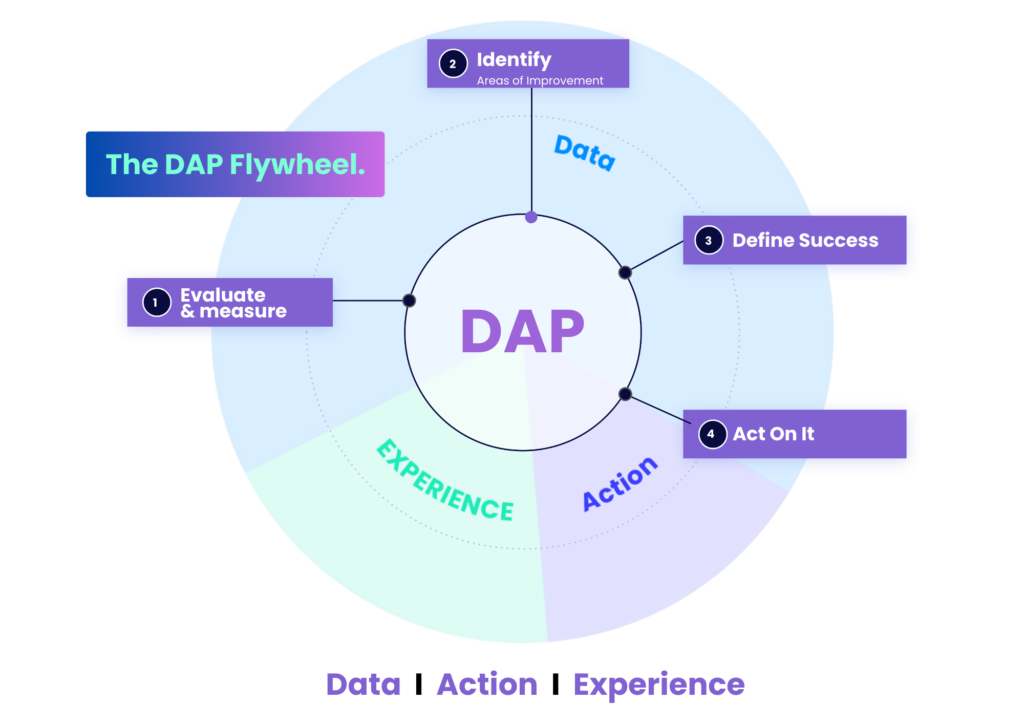
A powerful methodology requires a disciplined and transparent execution framework. erpOI’s implementation process is a structured, phased approach that translates the strategic vision of the OI Approach into tangible, high-quality digital adoption solutions. Drawing inspiration from proven frameworks like SAP Activate and the deep, practical wisdom contained within technical guides like WalkMe 101, our blueprint ensures predictability, quality, and a relentless focus on value at every stage.
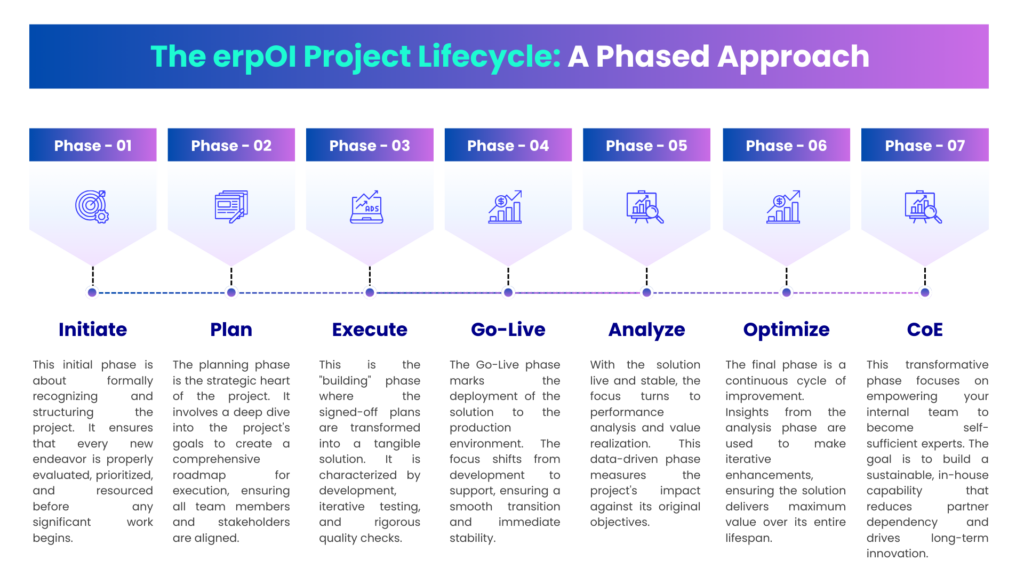
Discover & Strategize (The "Solutioning" Phase)
This foundational phase is where we align on the “why” and “what.” It is a highly collaborative process that brings together business stakeholders, process SMEs, and erpOI’s digital adoption experts.
We conduct workshops to identify the most critical business challenges and user pain points. We prioritize based on frequency, urgency, and direct impact on business KPIs—moving beyond vague requests to concrete, value-based objectives.
Our architects perform a technical validation of the target applications. We ensure WalkMe can successfully capture on-screen elements and that there are no underlying technical blockers (e.g., complex iFrames, non-standard code) that would hinder a successful implementation.
We collaboratively define the metrics of success. Whether it’s reducing support tickets by 40%, increasing process completion rates, or improving data quality, we establish a clear, measurable baseline before any building begins.
The output of this phase is a detailed, prioritized roadmap of digital adoption solutions to be built, complete with a clear scope and expected business impact.
Design & Build (The "Engineering" Phase)
This is where our certified WalkMe Builders and Designers translate the strategic roadmap into a functional user experience, applying the principles of Operations Integration.
Crafting the "Main Path"
As detailed in WalkMe 101, we begin by building the “skeleton” of a process—the most direct and straightforward path to completion. This focuses on structure and flow first.
Engineering for Resilience
We go beyond the basics to build for the real world. This includes:
- We use Splits to account for different user roles, data conditions, and process variations. For example, an approval workflow will have a different path for a manager than for an individual contributor.
- We implement Startpoints to allow users to begin a guided process from any logical step, ensuring the guidance is always relevant to their current context.
- We use Wait For steps and Custom Triggers to ensure our guidance remains perfectly synchronized with the application, even on pages with dynamic content or variable load times.
Human-Centric Design
Our UX specialists ensure that every piece of content—from the placement of a SmartTip to the wording in a Shoutout—is intuitive, helpful, and aligned with your brand’s voice and aesthetic.
Test & Assure (The "Quality Assurance" Phase)
Quality is a non-negotiable principle at erpOI. Our QA process is rigorous and multi-faceted, designed to ensure that every solution is not just functional, but flawless.
Our QA team follows a strict protocol, testing not only the “happy path” but also intentionally trying to break the experience by mimicking common user errors—clicking the wrong links, entering incorrect data, or navigating out of sequence.
We utilize advanced tools like the WalkMe Flow Tracker to get a real-time, step-by-step log of what the WalkMe engine is doing. This allows us to diagnose the root cause of any issue with precision, whether it’s a mis-evaluated rule, a timing issue, or an element that is not being correctly identified.
We test all solutions across all supported browsers and screen resolutions to ensure a consistent, high-quality experience for every user, regardless of their setup.
We facilitate UAT sessions with key business users to validate that the solution not only works technically but also effectively solves their real-world problems.
Deploy, Monitor & Iterate (The "DAP Flywheel" Phase)
The launch of a solution is not the end of the project; it is the beginning of the continuous improvement cycle.
We manage the publication of content to the production environment, preceded by a final “Solution Check Point” review to catch any overlooked issues. We confirm the correct deployment channel (snippet or master extension) is functioning perfectly.
Post-deployment, we immediately begin monitoring the solution’s performance using WalkMe Insights. We track adoption rates, goal completions, and user feedback to measure our success against the KPIs defined in Phase 1.
The data and insights gathered in this phase directly inform the “Discover & Strategize” phase of the next iteration. This creates the continuous improvement loop of the DAP Flywheel, ensuring that your digital adoption capability becomes more intelligent, more effective, and more valuable over time. This is the essence of the Transformation Continuum in practice.
Chapter 6:The OI Approach in Action-Detailed Pathways to HyperProductivity
The true measure of any methodology is its real-world impact. This chapter moves from the theoretical to the practical, showcasing how erpOI applies the Operations Integration and Intelligence (OI) Approach using WalkMe to solve complex business challenges across the world’s leading enterprise platforms. Each use case is a detailed narrative demonstrating our path from problem identification to quantifiable value creation, providing a concrete blueprint for achieving a state of HyperProductivity.
6.1 Salesforce: From Inaccurate Forecasts to Predictable Revenue Growth
Platform Focus
Salesforce Sales Cloud Scenario Title: Transforming the Quote-to-Cash Process and Ensuring Data Integrity.
The Business Challenge
A global manufacturing client was suffering from a classic case of low CRM adoption. Their sales team, comprising over 2,000 global users, viewed Salesforce not as a tool for success, but as an administrative burden. This manifested in several critical business problems:
Sales reps were failing to update opportunity stages consistently, leading to an unreliable pipeline and wildly inaccurate revenue forecasts for leadership.
Mandatory fields were being skipped, free-text fields were used incorrectly (e.g., using “Description” for internal notes), and crucial competitor information was missing, rendering reports useless. This directly contributed to a 41% business process error rate, a common industry ailment.
Reps spent an excessive amount of time on data entry and navigating complex approval processes, adding to their 36 wasted workdays per year and taking time away from customer-facing activities.
A newly implemented CPQ (Configure, Price, Quote) module was seeing less than 15% utilization because the team found it too complex and reverted to their old spreadsheet-based methods.
The erpOI Intervention (The OI Approach)
Operations Intelligence Phase (The "Why")
Our first step was to diagnose the root causes of these symptoms. We deployed WalkMe’s analytics suite to gather empirical data:
- UI Intelligence on the “Opportunity” object immediately revealed the fields with the highest error rates and abandonment. We discovered that the “Next Steps” field was skipped 85% of the time.
- WalkMe Insights Funnels were configured to track the end-to-end “Opportunity to Quote” process. The funnel showed a massive 70% drop-off when users were expected to engage with the new CPQ module.
- Session Playback on anonymous user sessions revealed that reps were frequently toggling between Salesforce and external spreadsheets, confirming the workflow was broken and the “Toggle Tax” was high.
Operations Integration Phase (The "How")
Armed with this data, we designed a holistic solution focused on integrating the people (sales reps) with the correct process (standardized sales methodology) via the technology (Salesforce).
- The solution was designed to be a “digital sales coach,” providing guidance and automation that felt helpful, not intrusive.
- We worked with sales leadership to codify their ideal sales process and built it directly into the Salesforce workflow, making the right way the easiest way.
- We used WalkMe to enhance the native Salesforce UI, adding guardrails, automating low-value tasks, and proactively guiding users.
WalkMe in Action (The Technical Build)
Our team of certified builders engineered a multi-layered WalkMe solution
A context-aware guide was initiated on all opportunities.
- Startpoints were configured so that if a user opened an opportunity at “Stage 3,” the guidance would begin from the relevant step, not from the beginning.
- Splits were used extensively. A rule evaluated if the “Amount” field was updated; if not, a branch guided the user to update it before proceeding. Another split checked if the “Competitors” field was populated, providing a specific checklist if it was empty.
- We attached a Validation SmartTip to the “Close Date” field. Using the Rule Engine, it checked if the selected date was in the past and, if so, displayed an error message until a future date was chosen. This was a “Governance” tactic to enforce data quality.
- An invisible SmartTip was placed over the “Description” field. On hover, it displayed a tooltip: “For customer-facing notes only. Use the ‘Internal Notes’ object for team comments,” guiding users to the correct behavior without cluttering the UI.
- A Launcher button labeled “Create Quote with CPQ” was placed on the opportunity page.
- Clicking this Launcher initiated a Smart Walk-Thru with Auto-Steps. It automatically navigated the user to the CPQ module, created a new quote, and pre-populated it with data from the opportunity (Account Name, Amount, etc.), eliminating several manual clicks and reducing the perceived complexity of the tool.
Tangible Outcomes & Illustrative ROI
Within six months of deployment, the client saw a dramatic turnaround:
Data quality score for opportunities increased by 75%. The consistency of stage updates led to a 90% accuracy rate in sales forecasting.
Time spent on administrative tasks per opportunity was reduced by an average of 12 minutes. Across 2,000 reps, this reclaimed thousands of hours of selling time per month.
Utilization of the CPQ module surged from 15% to over 85%, ensuring the ROI on that investment was finally realized.
“How-to” questions related to the sales process dropped by 60%, freeing up the IT support team.
Illustrative ROI Calculation
Productivity Savings: (12 min/opportunity) x (Avg. 10 opportunities/week/rep) x (2,000 reps) = 4,000 hours saved per week. At a blended rate of $50/hour, this translates to $200,000 per week or $10.4M annually in reclaimed productivity value.
This single use case demonstrates how the OI Approach directly combats the productivity losses crippling most enterprises, turning a cost center into a powerful engine for growth.
6.2 Microsoft Dynamics 365: Transforming Customer Service and Field Operations
Platform Focus
Microsoft Dynamics 365 Customer Service & Field Service Scenario Title: From Reactive Support to Proactive, AI-Enhanced Service Delivery
The Business Challenge
A leading telecommunications provider with a massive field service division was struggling to unify its customer service and field operations. Their technicians and support agents were working in silos, leading to significant inefficiencies.
Customer service agents lacked real-time visibility into technician schedules and parts inventory, leading to multiple follow-up calls and an abysmal 45% first-call resolution rate.
Dispatchers spent hours manually cross-referencing case notes in Dynamics 365 with technician skill sets and locations in a separate legacy system, resulting in delayed service and high operational costs.
Technicians in the field often missed critical pre-work safety checklists, which were buried in a separate knowledge base, creating significant compliance and liability risks.
The Dynamics 365 mobile app for field technicians was considered clunky and difficult to use, leading to technicians reverting to paper-based notes and delaying data sync until the end of the day.
The erpOI Intervention (The OI Approach)
Operations Intelligence Phase (The "Why")
- We analyzed the end-to-end “Case Creation to Work Order Resolution” process. The data clearly showed that the longest delay—averaging 4 hours—was between “Case Escalation” and “Technician Dispatch.
- We tracked user journeys within Dynamics 365. We observed that 80% of service agents navigated away from the “Case” entity to an external scheduling tool, confirming the “swivel-chair” problem. On the mobile app, we saw a 90% drop-off rate on the pre-work safety checklist page
Operations Integration Phase (The "How")
- We redesigned the workflow to be a single, unified process within Dynamics 365, eliminating the need for external tools.
- We used WalkMe’s cross-application capabilities to create a seamless experience, embedding critical information and actions directly where users needed them.
- The solution was designed to empower both service agents and field technicians, providing them with the right information at the right time to do their jobs effectively and safely.
WalkMe in Action (The Technical Build)
- A ShoutOut was configured to autoplay when a high-priority case was opened, reminding the agent of the SLA and providing a link to the relevant knowledge base article.
- Within the Case form, we embedded a WalkMe SmartTip next to the customer’s location. On hover, this SmartTip made a real-time API call (via WalkMe’s integration) to the field service module to show the nearest available technician, directly within the agent’s view.
- We created a Launcher “Smart Dispatch” on the Case page. When clicked, an Action Bot executed a complex workflow: it read the case details, identified the required skill set, found the best-qualified and nearest technician, and pre-populated the Work Order, leaving the dispatcher only to click “Confirm.”
- On the Dynamics 365 mobile app, we used WalkMe’s mobile capabilities to create a mandatory Smart Walk-Thru for the safety checklist.
- Spotlight was used on each checklist item, preventing the technician from proceeding until they had checked off each safety measure. This “Governance” pattern ensured 100% compliance.
Tangible Outcomes & Illustrative ROI
Increased from 45% to 80% by providing agents with real-time technician availability.
“Smart Dispatch” automation reduced the time to dispatch a technician from an average of 4 hours to under 15 minutes.
The mandatory safety checklist achieved 100% completion, eliminating a major source of risk.
The simplified, guided mobile experience increased active daily usage of the app by 300%.
6.3 Workday: Achieving Day-One Proficiency for a Hybrid Workforce
Platform Focus
Workday HCM Scenario Title: Revolutionizing Employee Onboarding and Self-Service Enablement
The Business Challenge
A rapidly growing tech company with a hybrid workforce model was facing significant challenges with employee onboarding and HR process adoption. Their lean HR team was overwhelmed with repetitive questions, and new hires felt disconnected and unproductive for their first few weeks.
The onboarding process was a confusing mix of emails, static documents, and system tasks in Workday. New hires struggled to find where to complete critical tasks like setting up direct deposit, enrolling in benefits, and completing I-9 verification.
The HR team was spending an estimated 30% of their time answering basic, repetitive “how-to” questions from the 5,000+ employee base, detracting from strategic initiatives.
Complex but infrequent processes like life event changes or performance review goal-setting had near-zero adoption, with over 90% of employees submitting an HR ticket instead of using the system.
There was no standardized process for managers to track their new hire’s onboarding progress, leading to an inconsistent experience.
The erpOI Intervention (The OI Approach)
- WalkMe Insights was deployed to analyze user behavior in Workday. We found that the average user session on the “Benefits Enrollment” page was less than 30 seconds before navigating to the “Contact HR” page, indicating immediate confusion and abandonment.
- Surveys were deployed via WalkMe to new hires after their first week. The qualitative feedback was overwhelming: 85% reported feeling “lost” and “unsure of what to do next.”
- We used WalkMe to create a single, centralized, and guided onboarding experience directly within Workday, making it the single source of truth.
- The solution was segmented to provide a personalized experience for different roles (e.g., individual contributors vs. managers) and locations.
WalkMe in Action (The Technical Build)
- An Onboarding Tasklist was configured to appear for any user whose “Hire Date” variable was within the last 30 days.
- The tasklist was segmented. For US-based employees, it included a task for I-9 verification that was hidden for international employees. For managers, an additional task, “Complete Manager’s Welcome Guide,” was added.
- Each task launched a specific Smart Walk-Thru that guided the user step-by-step through the process in Workday.
- We created a Smart Walk-Thru for the “Change a Life Event” process. This was attached to a Launcher on the HR homepage.
- Crucially, we used a ShoutOut with an autoplay rule based on a user’s wedding or new child announcement on the company’s internal social platform (via integration), proactively guiding them to the relevant process.
- We built a custom “Manager Dashboard” within Workday using WalkMe. It used WalkMe’s API to check the completion status of their new hire’s onboarding tasks and displayed a simple progress bar, giving managers real-time visibility.
Tangible Outcomes & Illustrative ROI
New hire time-to-full-productivity was reduced from an average of 4 weeks to 1 week.
Repetitive “how-to” tickets submitted to the HR team dropped by 80%, saving thousands of hours of administrative work annually.
Adoption of the “Change a Life Event” self-service process increased from under 10% to over 95%.
The company’s new hire satisfaction score (measured via a post-onboarding survey) jumped by 40 points.
6.4 SAP SuccessFactors: Mastering the Hire-to-Retire Lifecycle
Platform Focus
SAP SuccessFactors Suite (Employee Central, Performance & Goals, LMS)
Scenario Title
Unifying Talent Management and Driving Continuous Performance
The Business Challenge
A Fortune 500 company had invested heavily in the SAP SuccessFactors suite but was failing to realize its value. The modules felt disconnected, and critical HR processes were inconsistent across different business units.
The “Hire-to-Retire” process was not a seamless journey. For example, after completing onboarding in Employee Central, there was no clear handoff to the Learning Management System (LMS) for mandatory training.
Managers across different regions were using different rating scales and inconsistent language when setting goals, making enterprise-wide talent calibration nearly impossible.
The Learning Management System was seen as a compliance tool rather than a development tool. Employees only completed mandatory training, and voluntary course enrollment was below 5%.
Critical workflows, such as approving compensation changes, lacked sufficient guardrails, creating risks of non-compliance with internal policies.
The erpOI Intervention (The OI Approach)
- WalkMe Insights Funnels were used to map the “New Hire to Training Completion” journey. The data showed a 90% drop-off between the final onboarding step and the first LMS login, confirming the process was broken.
- UI Intelligence on the Performance & Goals module revealed that less than 20% of managers were using the “Goal Alignment” feature, which was critical for their corporate strategy.
- Our core strategy was to use WalkMe to create the “connective tissue” between the SuccessFactors modules, transforming a collection of disparate tools into a single, intelligent talent management platform.
- We focused on creating standardized, guided workflows for critical processes to ensure consistency and compliance across the entire organization.
WalkMe in Action (The Technical Build)
- We created a Smart Walk-Thru for the final step of the new hire process in Employee Central.
- Upon completion of this step, a Shuttle was automatically triggered, redirecting the user seamlessly from Employee Central directly to their personalized “My Learning Plan” page in the LMS module.
- We built a comprehensive Smart Walk-Thru for the annual performance review process.
- A Validation SmartTip was placed on the goal-setting fields, using a rule to check for specific corporate keywords and ensuring every goal was aligned with strategic pillars.
- Within the rating section, SmartTips were attached to each rating, providing standardized definitions to ensure managers everywhere were using the same criteria.
- Based on the user’s role and performance goals, a ShoutOut would proactively recommend relevant voluntary courses from the LMS, complete with a direct enrollment link.
Tangible Outcomes & Illustrative ROI
The automated handoff from onboarding to training ensured that 100% of new hires accessed the LMS within their first week.
The guided performance review process increased the use of the “Goal Alignment” feature by 400%, providing leadership with clean, consistent data for talent planning.
The proactive course recommendations led to a 150% increase in voluntary LMS course enrollment.
Chapter 7: Building Your Digital Adoption CoE with erpOI
The transformative results detailed in our use cases are not the product of one-off projects; they are the output of a sustained, strategic capability. The State of Digital Adoption reports make it clear: the difference between laggards and “Elite Digital Adopters” is the presence of a mature digital adoption strategy. The organizational structure that governs, scales, and sustains this strategy is the Digital Adoption Center of Excellence (CoE).
Our research shows that 73% of enterprises now have a CoE with six or more dedicated employees. This is no coincidence. A CoE is the engine room for the Transformation Continuum. It is where the principles of our OI Approach are operationalized and scaled across the enterprise.
However, building an effective CoE is a significant undertaking. It requires a clear charter, executive sponsorship, defined roles and responsibilities, and a robust governance model. This is where erpOI transitions from a solution provider to a strategic partner. We don’t just deliver a project; we empower our clients to build a lasting, internal capability for continuous improvement. Our end-to-end service portfolio is a direct blueprint for establishing and maturing your Digital Adoption CoE.
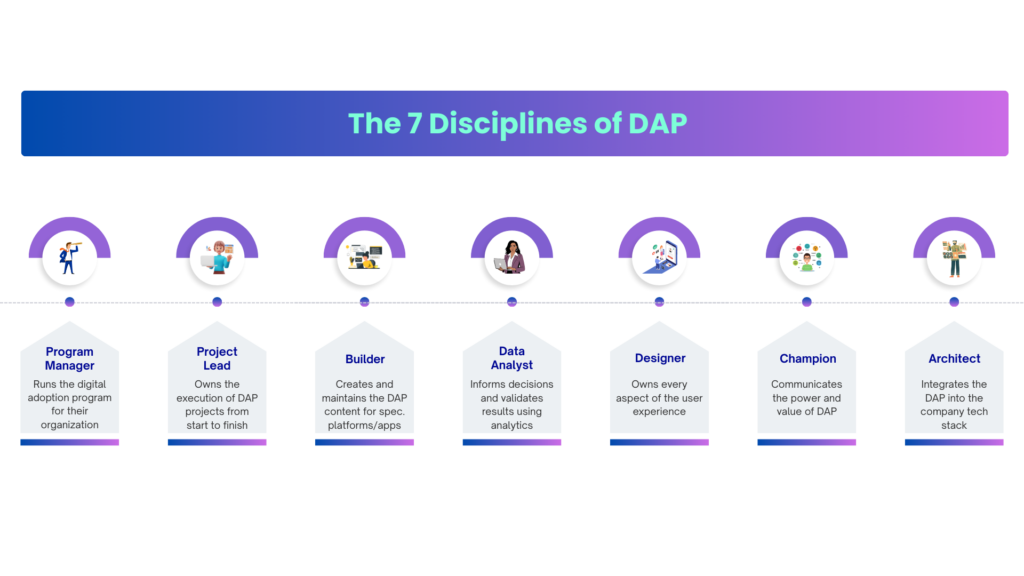
7.1 From Ad-Hoc to Strategic: Our Service Portfolio as Your CoE Framework
erpOI’s services are designed to map directly to the functions of a high-performing CoE, providing the expertise and resources necessary at each stage of maturity.
1. Strategic Advisory & Digital Adoption Planning (Establishing the CoE Charter)
Function
Defining the CoE’s mission, governance model, and strategic roadmap. This is the domain of the Program Manager and Champion.
erpOI's Role
We partner with your leadership to facilitate the foundational steps. We help you:
- Articulate the CoE’s vision, scope, and key objectives, aligning them with high-level business goals like increasing ROI or improving employee satisfaction.
- Design a practical governance model (Centralized, Hybrid, or Decentralized) that fits your organization’s culture and scale. We help create the intake process for new requests and the prioritization framework based on value and effort.
- We leverage industry data and our ROI models to build a compelling business case, securing the executive sponsorship that is critical for the CoE’s long-term success.
2. Full-Scale Implementation & Configuration (Building the Technical Foundation)
Function
Architecting and deploying the DAP technology in a secure, scalable, and efficient manner. This is the core responsibility of the Architect.
erpOI's Role
Our technical experts manage the end-to-end setup of the WalkMe platform. We ensure that:
- We manage the deployment of the WalkMe snippet or mass browser extension, ensuring full coverage across all relevant applications.
- We work with your IT and security teams to configure WalkMe in compliance with all data privacy and security requirements, including SSO integration and adhering to CSPs.
- We configure the Unique User Identifier (UUID) and set up integrations with your other systems of record (like your HRIS or BI tools) to enable robust segmentation and analytics.
3. Expert Content Creation & UX Design (The Engine of User Enablement)
Function
Designing and building the in-app guidance, automation, and communication that drive the user experience. This is where the Builder and Designer roles excel.
erpOI's Role
Our team of certified WalkMe builders and UX specialists are masters of the platform. We don’t just build content; we engineer experiences.
- We apply UX best practices to ensure all guidance is intuitive, non-intrusive, and genuinely helpful.
- We leverage the full power of the WalkMe toolset—from complex, multi-layered Smart Walk-Thrus with conditional logic to sophisticated automation sequences—to solve your most challenging process issues.
- We ensure that all WalkMe content is perfectly aligned with your corporate branding, creating a seamless and professional user experience.
4. Advanced Analytics & Continuous Improvement (The Intelligence Hub)
Function
The ongoing operation, maintenance, and expansion of the digital adoption program. This encompasses all CoE roles.
erpOI's Role
For many organizations, our Managed Services are the most effective way to ensure the long-term success of their CoE. We can act as an extension of your team or as your fully outsourced CoE. We provide:
- We handle the continuous stream of new requests for guidance and automation.
- We manage content updates required by underlying application changes, conduct regular health checks, and ensure the platform runs smoothly.
- We provide ongoing strategic consultation, helping you navigate the Transformation Continuum and prepare for the next wave of technological change, including new AI integrations.
By partnering with erpOI, you are not just purchasing a service; you are investing in a strategic capability. We provide the expertise, methodology, and resources to build a world-class Digital Adoption CoE that will serve as the engine of your transformation journey for years to come.
Chapter 8: Conclusion - From Digital Adoption to Enduring Business Transformation
The digital landscape is littered with the remnants of failed transformation projects—expensive, sophisticated systems that promised a revolution but delivered only complexity and frustration. The $104 million in annual losses from digital inefficiencies is not a symptom of bad technology, but of a broken methodology. The traditional, technology-first approach has failed.
The evidence is overwhelming: success in the digital era is not determined by the power of your software, but by the effectiveness of your adoption strategy. The “Elite Digital Adopters”—the top 7% of organizations achieving a remarkable 85% ROI—have proven that a human-centric, data-driven, and continuous approach is the only path to sustainable value.
This whitepaper has laid out a definitive blueprint for joining this elite group. The erpOI Transformation Continuum provides the strategic vision, moving beyond finite projects to a state of perpetual evolution. Our proprietary Operations Integration and Intelligence (OI) Approach offers the methodology—a powerful flywheel that unifies People, Process, and Technology while fueling itself with actionable, data-driven insights.
We have demonstrated how this approach, when activated by the world-class capabilities of the WalkMe Digital Adoption Platform, solves the most pressing challenges of the modern enterprise. It closes the visibility gap, eliminates the toggle tax, ensures data integrity, and drives the adoption of critical business processes. Most importantly, it provides a governed, scalable framework for embracing the transformative potential of AI without succumbing to its risks.
The choice for every enterprise leader is stark. You can continue down the path of accumulating transformation debt, where each new technology adds another layer of complexity and cost. Or, you can choose the path of the Elite Digital Adopter.
This is a journey toward a state of HyperProductivity, where your technology stack becomes a seamless and intuitive engine for growth, and your employees are empowered to work at the peak of their abilities. This is not a distant vision; it is a tangible, achievable reality. erpOI has the blueprint, the expertise, and the partnership
AUTHORS

SANJAY MAHAJAN
walkme, eppm,leanlx & sap dsc sme

RAVVE MANIRA
sap signavio & sap isbn sme
EDITOR & PUBLISHER

TEJAS CHAUDHARI
Digital Adoption Consultant (Operations Specialist )
We have created this white paper to expose the painful reality: digital transformation fails when it ignores the user, leading to a $104M loss annually.Our Operations Integration & Intelligence (OI) Approach is the blueprint for ‘Elite Digital Adopters’, achieving a proven 85% ROI by mastering human adoption.
Struggling with low adoption? Review the paper, then reach out to me for a demo and let’s turn your ‘Software Paralysis’ into HyperProductivity.

Contact Information
For Further Inquiries
www.erpOI.com | Info@erpOI.com | Offices in Sweden, India & UAE
